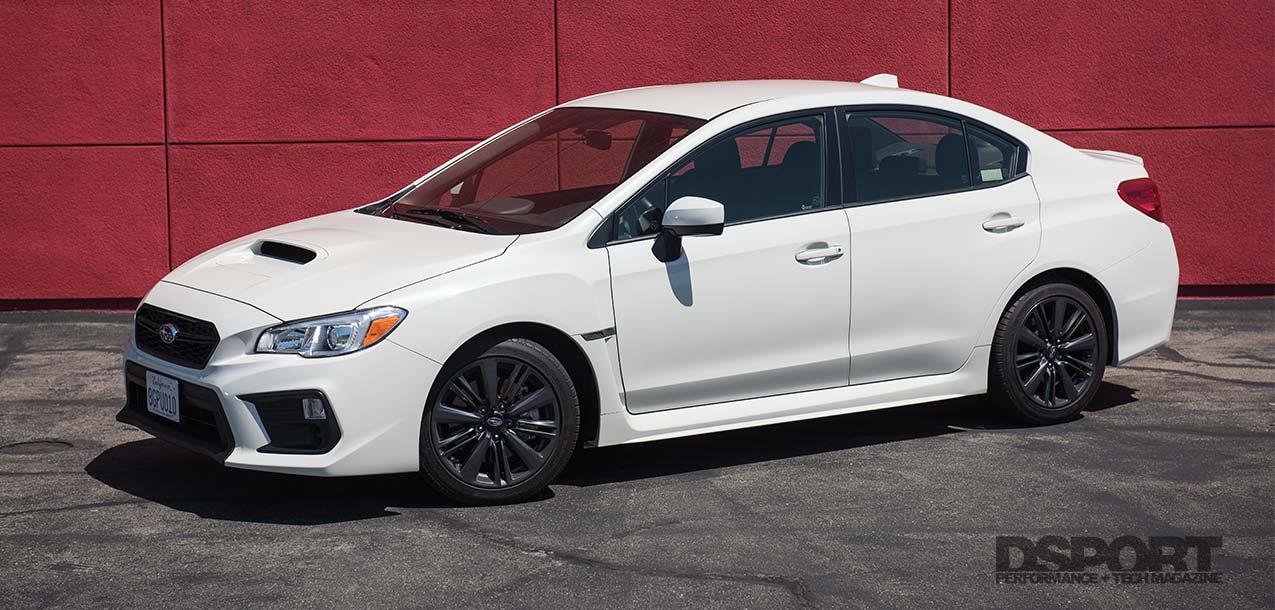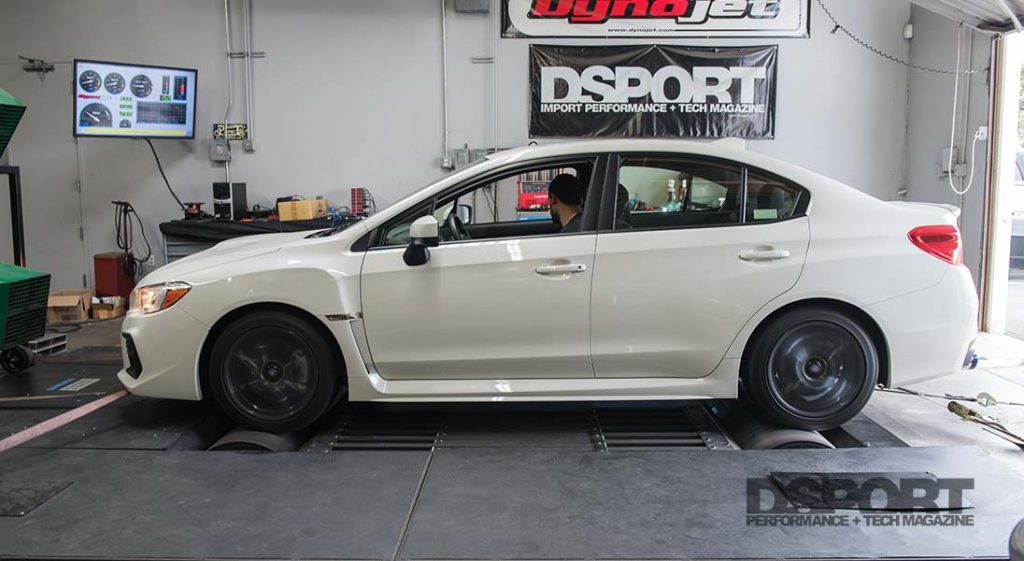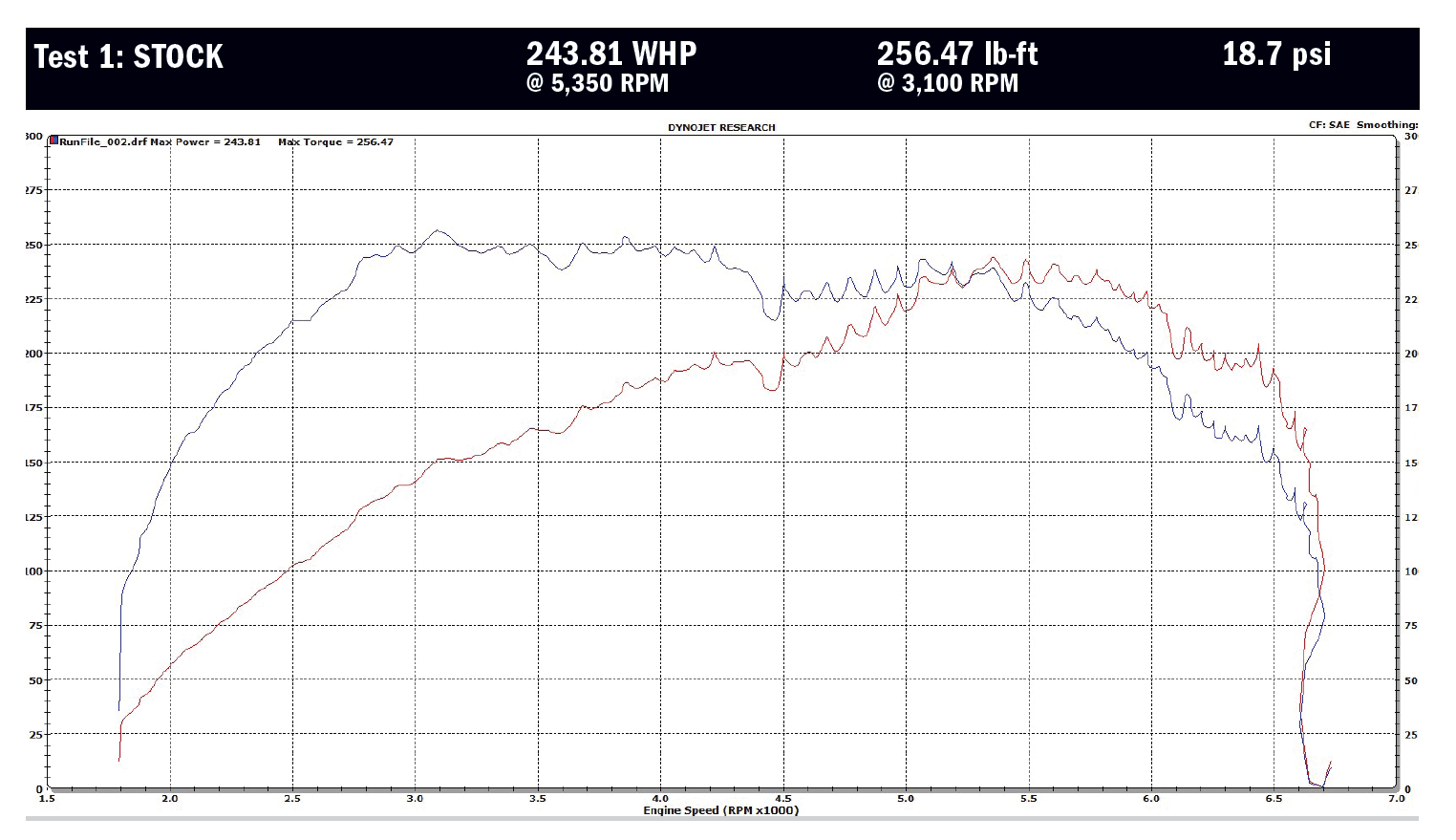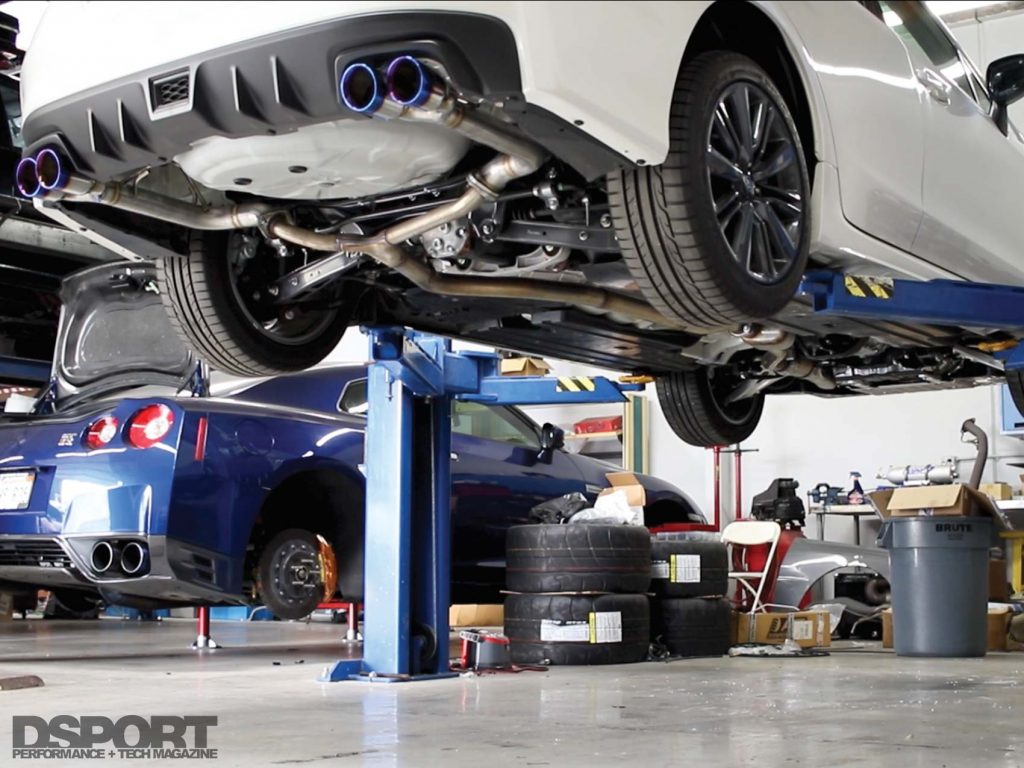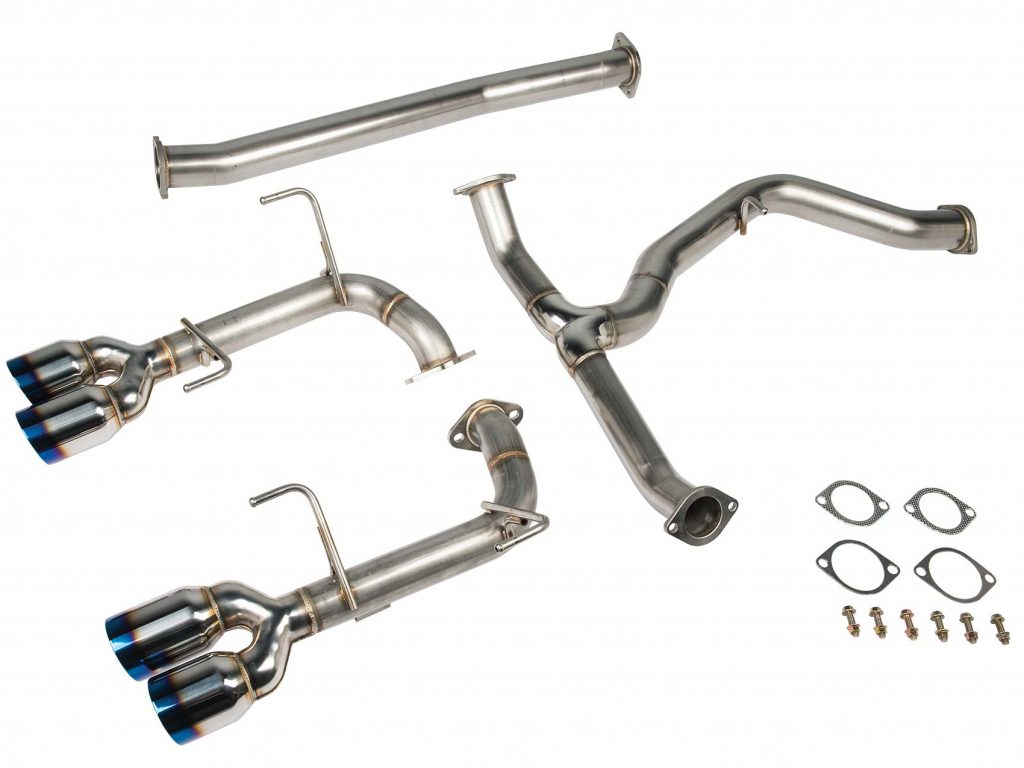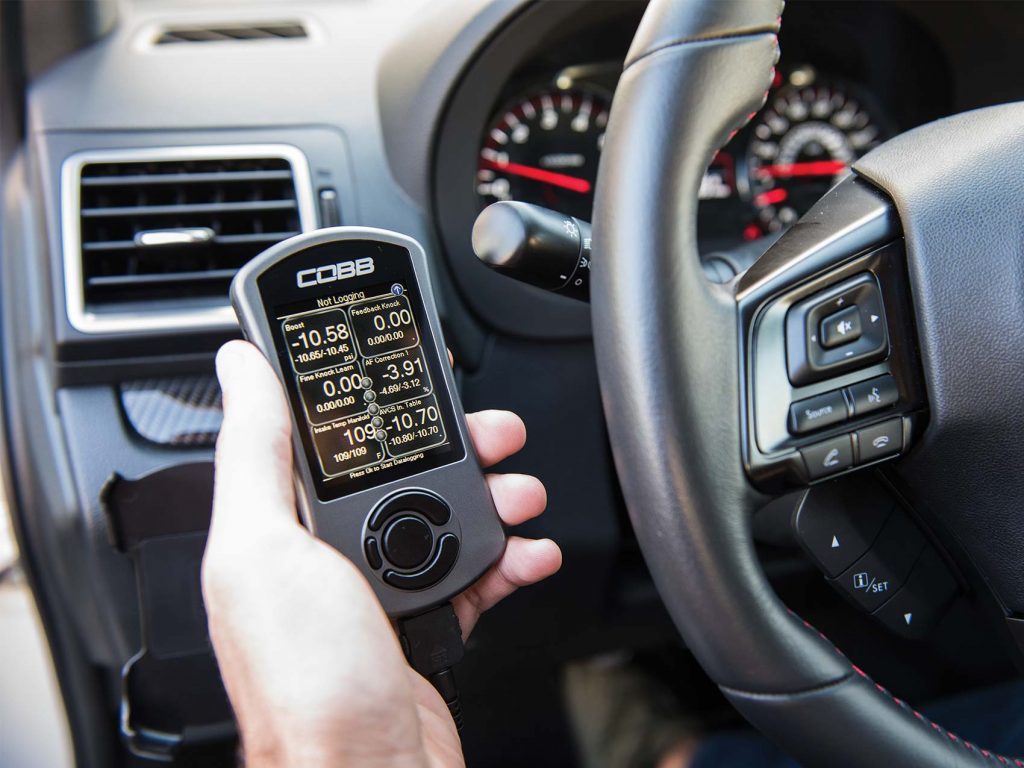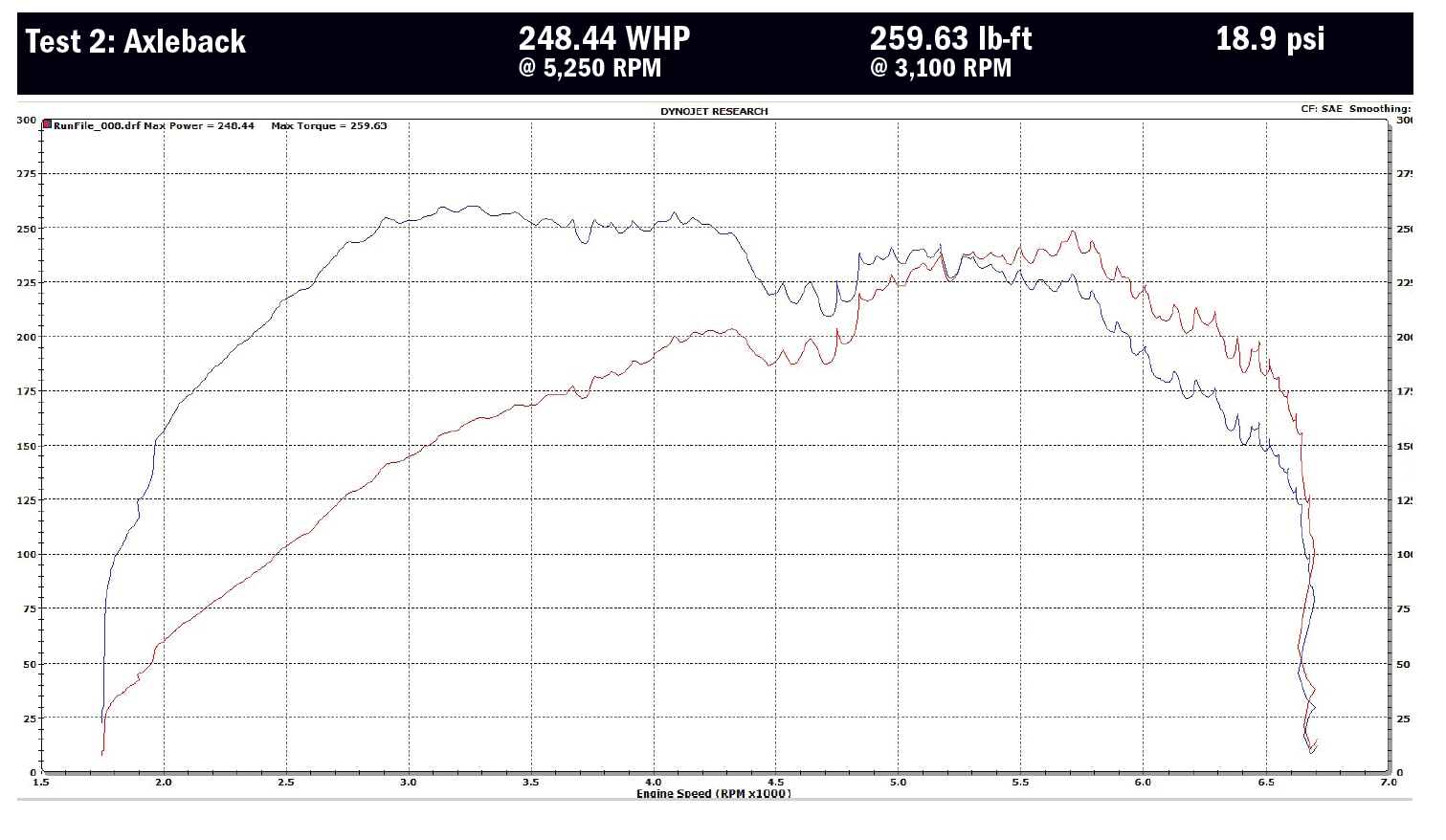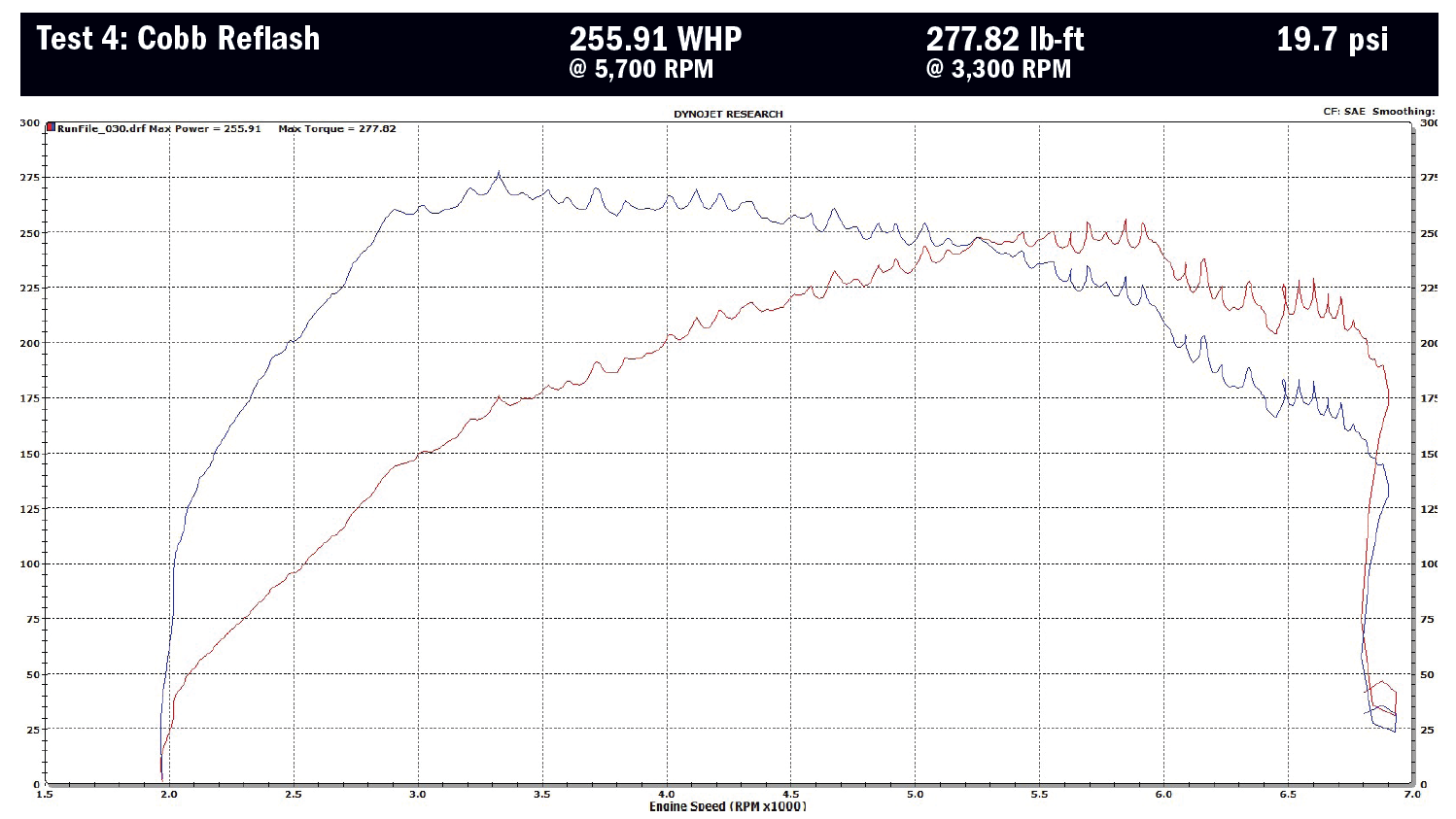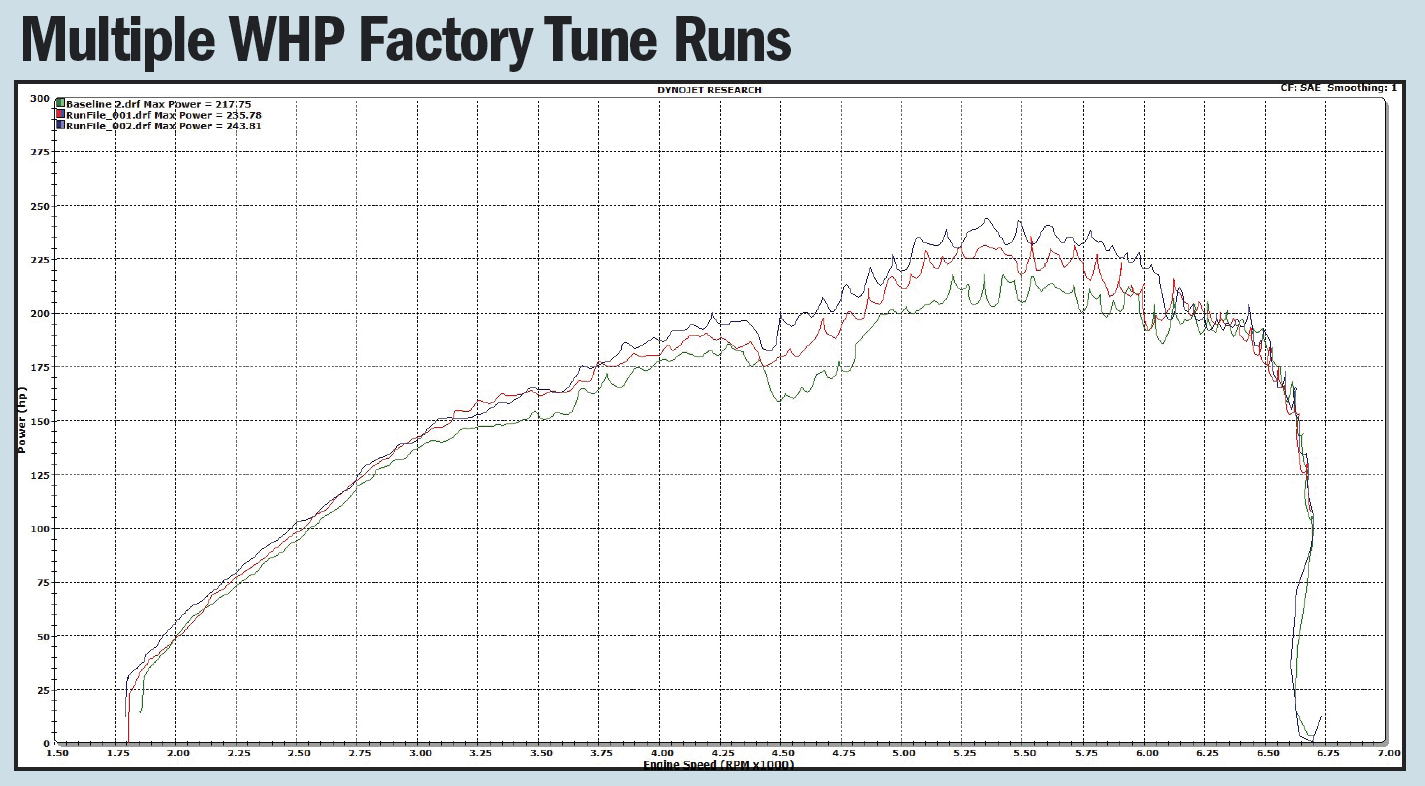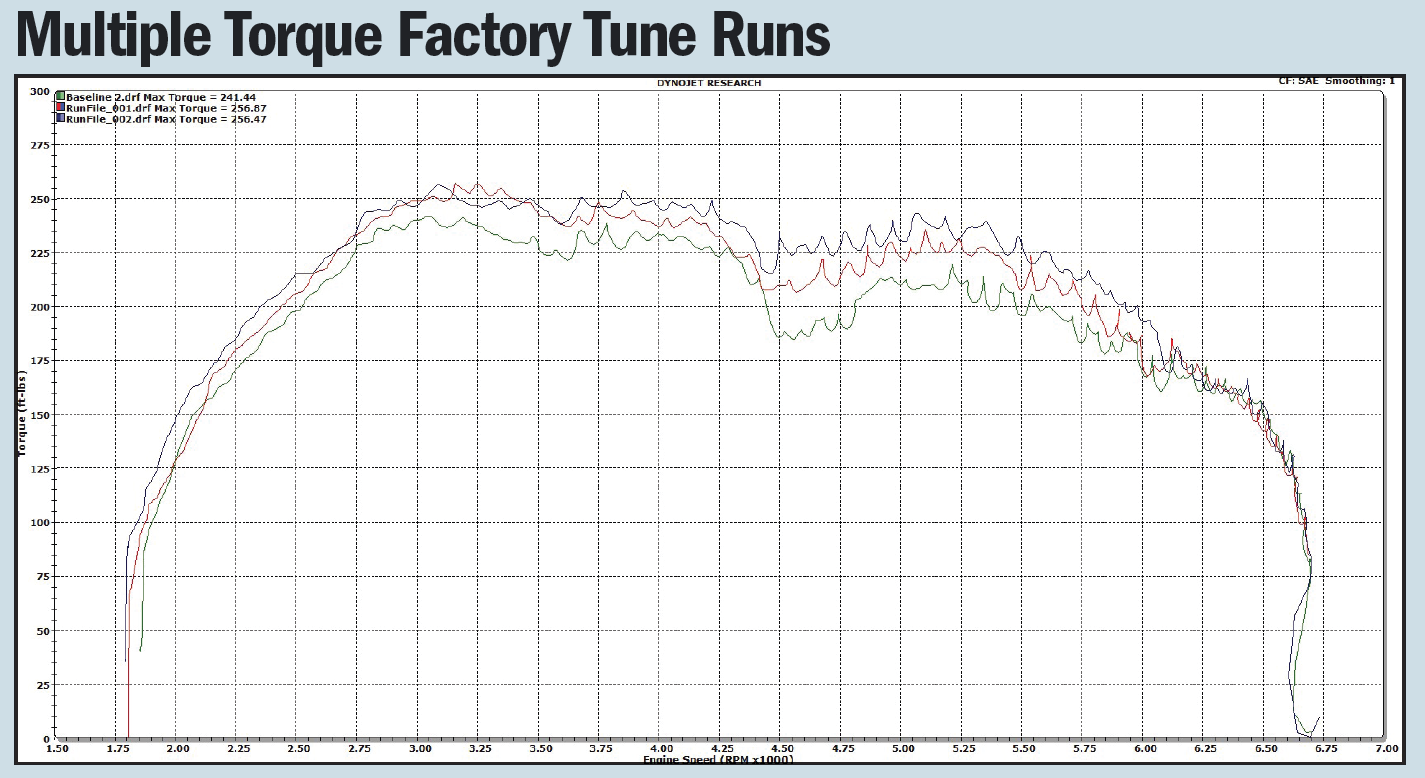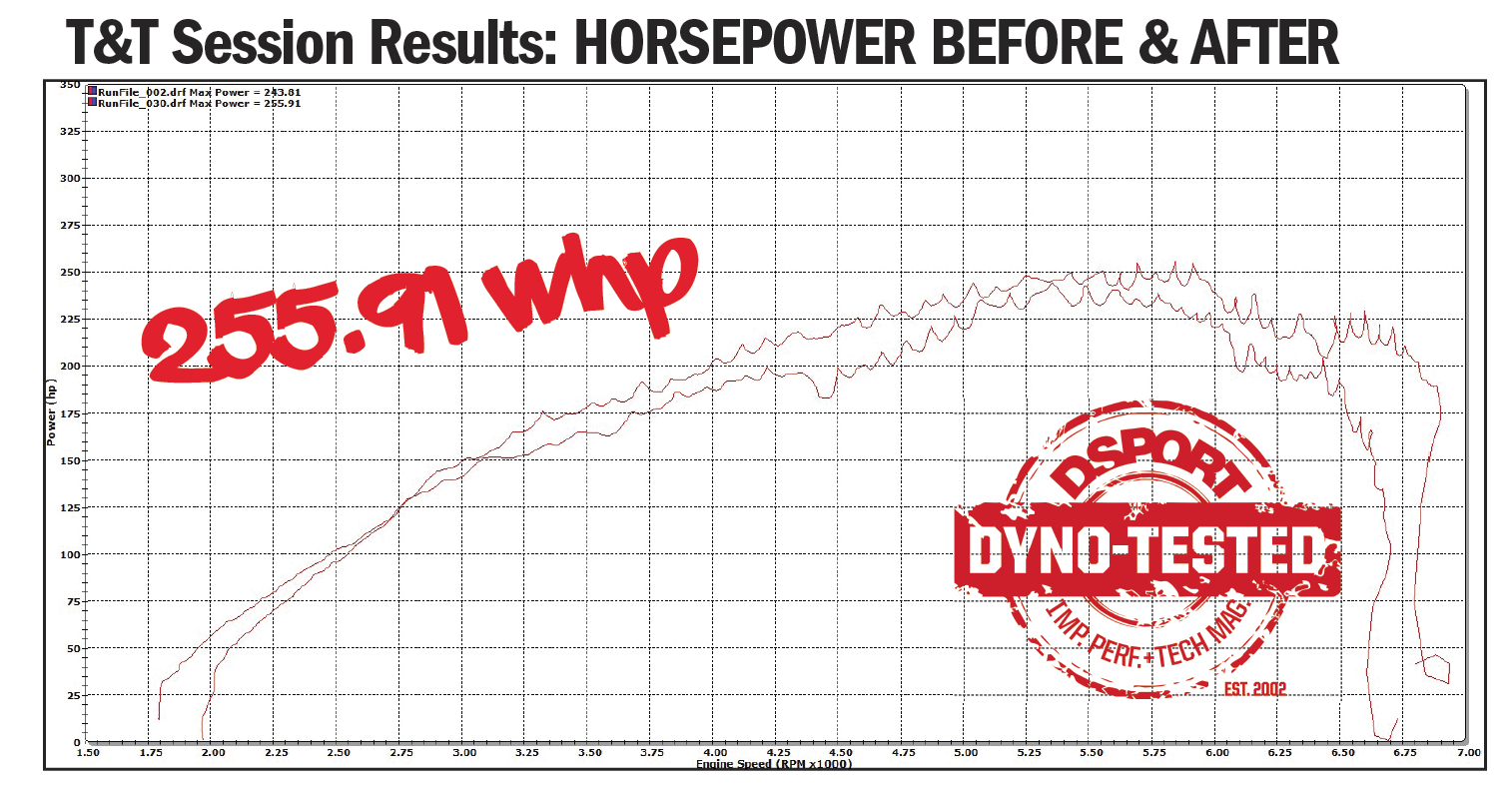Let’s do it! In the previous issue of DSPORT, we introduced you to our latest D’GARAGE projects: a 2019 Subaru WRX and a 2019 Honda Civic Si. We explained that both cars will go through various stages of upgrades, and to continue measuring the progress, we will race at the end of each stage on the drag strip. As you may have guessed, we will keep you up to date with our stages and race results, so be sure to keep a close eye on every issue of DSPORT as well as our YouTube channel. If you own a Subaru WRX or a Honda Civic Si, this battle will serve as a map of dos and don’ts so you make the right decisions for your car and refrain from any useless upgrades. In this story, we will cover the first stage for the Subaru WRX.
Text by Bassem Girgis // Photos by Joe Singleton
DSPORT Issue #208
Stage 1
We’ve been experimenting with numerous brand-new platforms lately, and we learned a lot about how these new ECUs behave on different platforms. While we usually take a specific route for most of our Test and Tunes, we decided to switch some of the order of upgrades. By changing the order of modifications, parts that gave us no advantages in the past could show more benefits. Stage 1 for this Subaru WRX will consist of two variations of an exhaust system, followed by an ECU reflash. If you live in California, you are most likely aware of the stricter exhaust noise law for exhaust systems louder than 95dB at specific RPMs. Read on to see our sound testing for both the REMARK Axleback and Catback exhaust systems.
The Baseline
The 2019 Subaru WRX is equipped with a 2.0-liter turbocharged, direct-injection, flat-four (Boxer) engine. The Boxer engine delivers 268 horsepower and 258 lb-ft of torque to the flywheel. On our dyno, our D’GARAGE WRX delivered 244 peak wheel horsepower and 256 lb-ft of peak torque. Before going crazy with this baseline, read on to understand why our completely STOCK WRX delivered such high numbers to all-four of its wheels.
The Parts
We normally start our Test and Tunes with an intake system, but as of lately, we haven’t been getting the results we were used to getting from this simple upgrade (we experienced lack of results while testing a Focus RS, Civic Type R, and more). Since we live in California, we wanted to address the exhaust noise laws first, so we opted for the REMARK Axleback, given the mufflers probably serve as restrictions in the back end of the exhaust. We then moved on to the full REMARK catback exhaust system to see if there is any difference when we change the mid-pipe. Finally, we wrapped up the first level of upgrades with a Cobb Accessport Stage 1 91 Octane off-the-shelf map.
REMARK Axleback/Muffler Deletes
The REMARK axleback is a direct bolt-on that eliminates your factory mufflers, which are believed to be the main restrictions in the exhaust system past the downpipe (which is most likely the biggest restriction in your exhaust system). Constructed from 2.5-inch 16-gauge T304 stainless steel mandrel bent pipes, the axleback comes with an optional burnt stainless finish, or regular stainless finish. At the end of the high-quality, hand-welded 2.5-inch pipes are quad 3.5-inch tips. This system comes equipped with everything you need to finish the installation, including gaskets, bolts, and nuts.
REMARK Catback Exhaust
The full REMARK catback exhaust is basically the axleback plus two mid-pipes. You can buy them separately or as a full system. Both products come with everything you need for installation.
The full REMARK catback exhaust system consists of the exact same Axleback when buying it separately, with added two-piece mid-pipes (3-inch split to 2.5-inch). The mid-pipes use the same factory exhaust hanger locations, while providing larger diameter when compared to the factory pipes. The Catback exhaust system comes with the axleback above and features the same type of 16-gauge T304 stainless steel pipes. This system comes with everything you need to successfully finish the installation.
Cobb Accessport
In addition to off-the-shelf maps and custom tuning, the Cobb Accessport can display just about any gauge you want. When mounted, you won’t need any additional gauges in your car.
If you want quick and easy power, the Cobb Accessport will deliver just that, and more. This small tool unlocks hidden power by replacing conservative factory settings in the vehicle’s ECU with more aggressive calibrations. The Accessport comes equipped with various off-the-shelf maps that you can quickly use to reflash your ECU. Each map is ideal for a specific level of modifications. In our case, we used the Cobb Accessport Stage 1 91 Octane calibration. The Accessport offers many more features, most notably data-logging and live in-car performance gauges (not to mention custom tuning).
Axleback/Muffler Deletes – Dyno
After a quick installation, we strapped the WRX on the dyno to see if the axleback makes any difference. With the REMARK muffle deletes, the WRX delivered 248.44 peak whp and 259.63 lb-ft of peak torque. This is a 4.63 peak whp difference and 3.16 lb-ft of peak torque. The power and torque curves showed minimal improvement, but the real noticeable difference was the exhaust note. The REMARK axleback significantly improved and increased the exhaust note and completely changed the personality of our Subaru WRX. Does the axleback keep the WRX legal according to the SAE testing procedure? Well, in terms of sound, the Axleback is right on the verge of being over 95dB, but realistically, California requires all motor vehicles to keep the mufflers, so you just need to make this decision for yourself.
Full Catback Exhaust System – Dyno
Installing the mid-pipes is as easy as installing the axleback. With the full system on, we re-strapped the WRX on the dyno, this time delivering the same peak wheel horsepower (248.67whp) and a mildly improved peak torque (261.23 lb-ft of torque). The OEM mid-pipe proved to be efficient enough from the factory, and the mufflers were causing a small restriction when combined with the rest of the stock components. However, the full catback exhaust system surprised us in regards to sound, delivering a lower note than the axleback, and an even lower note than the factory system at some RPMs. Personally, the full REMARK catback exhaust offers the best tone when compared to just the muffler deletes or the factory system. It’s quiet when it’s warm, but deep when you get on the throttle.
ECU Reflash – Dyno
In addition to the peak power and torque increase, the Cobb tune smoothed out the giant drop between 4,200-5,000 RPM. This completely changes the driving feel of the WRX.
It was finally time to reflash the ECU. Reflashing the WRX is as easy it gets. You simply need to follow some simple instructions on your Cobb Accessport, and you’re all set. We chose the Cobb Stage 1 91 Octane map to start with since our WRX is near stock. On the dyno, the Cobb reflash allowed our FA20 engine to deliver a peak 255.91whp and a peak 277.82 lb-ft of torque. This is a 12.1 peak whp gain and a peak 21.35 lb-ft of torque increase. Most importantly, the Stage 1 91 Octane tune significantly improved the massive dip in both horsepower and torque between 4,200 RPM and 5,000 RPM, which we believe happens due to poor head flow design in the FA20 heads.
On the factory tune, our Subaru WRX delivered a wide range of power numbers. Recording anywhere between 217whp and 243whp, you never know what you’re getting during your pull.
While torque stayed more consistent on the factory tune, it still varied between 241 lb-ft and 256 lb-ft of torque. The Cobb Accessport tune, however, delivered nearly identical numbers during every dyno pull.
Oops, Factory Tune Sucks
After wrapping up this stage of our Test and Tune, we weren’t happy with the results. We’ve tested numerous Cobb tunes, ranging from off-the-shelf maps to complete custom tuning, and we’ve always experienced better results. We consulted Mike McGinnis, Senior Engine Calibrator at Cobb, and it turned out the factory ECU tune is simply inconsistent. During all of our testing, we like to choose the highest dyno runs recorded to ensure we are as firm as possible. However, after further analyzing all of our dyno runs, we discovered how truly “all-over-the-place” the factory tune behaves. Our runs varied from 217whp to 243whp, while the Cobb tune remained almost identical the entire time. To explain it better, if you’re driving your factory-tuned WRX, you could be getting 217whp during one pull, 243whp in the next, and anything in between in other pulls. With the Cobb tune, however, as long as your engine is cool, you know you’re getting the same amount of power each time (given you’re repeating your driving behavior). With this in mind, we can argue that the Cobb Stage 1 91 Octane Map provided a 12.1whp gain, or a 38whp gain, depending on the factory ECU’s mood.
On to the Next
After driving the Subaru WRX with the REMARK exhaust and the Cobb Stage 1 91 Octane Tune, the fun factor has gone up. The exhaust offers the right note throughout the entire RPM range and you will not get sick of it. The Cobb tune smoothens out acceleration, making it feel linear and quick, with more forgiving shifting and a much-reduced rev-hang. Next up, we will be bringing Mike from Cobb back to experiment with some custom tuning, introduce a vertical intercooler to our FA20, downpipe, and eventually flex-fuel. Before we get crazy with this WRX, however, be sure to stay up to date with our challenger, the Honda Civic Si, that will be wrapping up its Stage 1 of its Test and Tune in the upcoming issue of DSPORT and on our YouTube channel.


